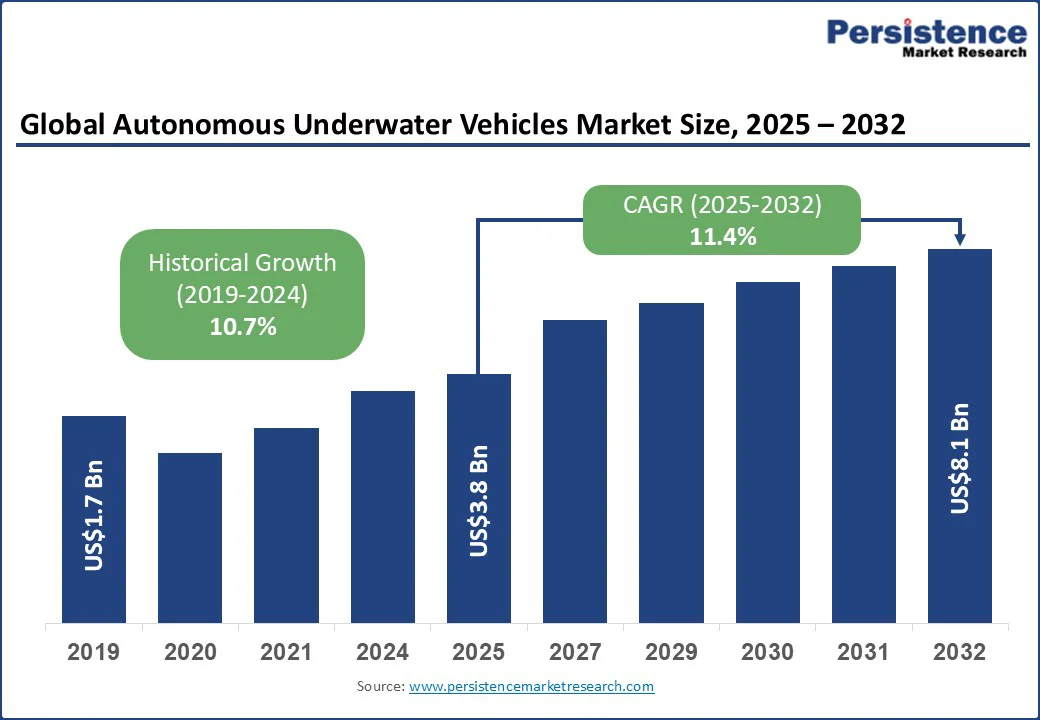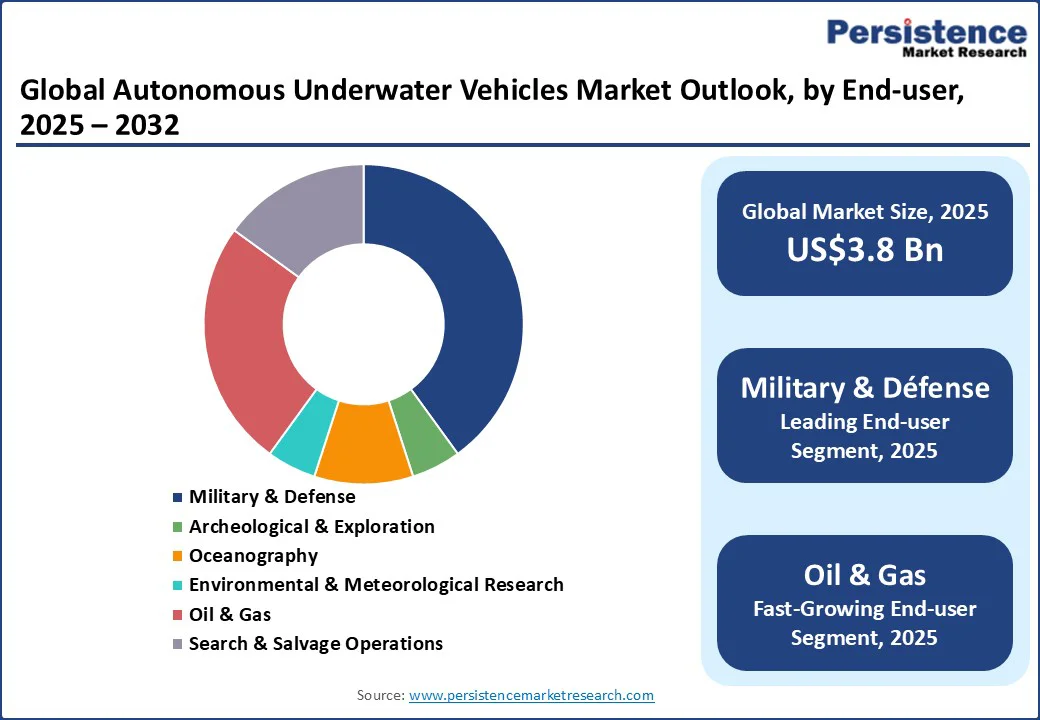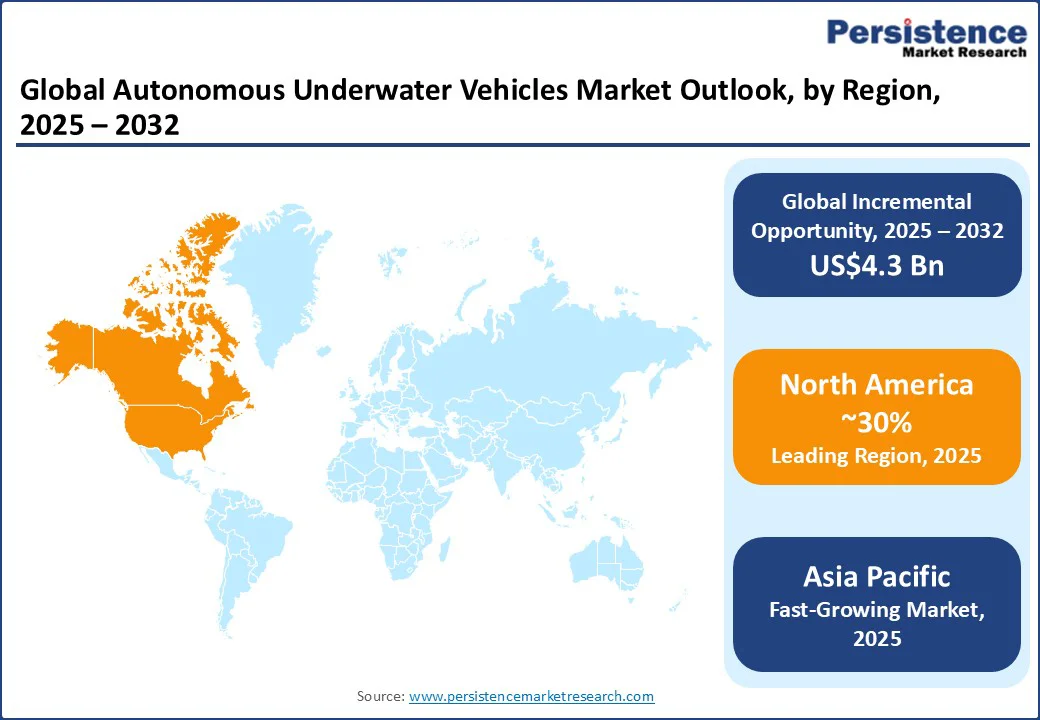ID: PMRREP19330| 195 Pages | 19 Sep 2025 | Format: PDF, Excel, PPT* | Automotive & Transportation

The global autonomous underwater vehicles market size is likely to be valued at US$3.8 Bn in 2025 and is expected to reach US$8.1 Bn by 2032, growing at a CAGR of 11.4% during the forecast period from 2025 to 2032, driven by rising investments in offshore oil and gas drilling, advancing AUV technologies, and increased focus on maritime security.
Key Industry Highlights

| Global Market Attribute | Key Insights |
|---|---|
| Autonomous Underwater Vehicles Market Size (2025E) | US$3.8 Bn |
| Market Value Forecast (2032F) | US$8.1 Bn |
| Projected Growth (CAGR 2025 to 2032) | 11.4% |
| Historical Market Growth (CAGR 2019 to 2024) | 10.7% |
Piracy and maritime terrorism pose serious threats to global shipping, resulting in significant economic losses and risks to human lives. Additional challenges, such as drug trafficking and migrant smuggling, further endanger maritime security.
To counter these threats, AUVs are increasingly being deployed for Intelligence, Surveillance, and Reconnaissance (ISR) operations, enhancing safety at sea and driving market growth. The sector also benefits from rising public sector investments in innovation, technological advancements, and expanding security control functions.
A key concern lies in the protection of underwater communication cables, which transmit sensitive international data. Monitoring these infrastructures relies heavily on advanced sensor technologies integrated with AUVs. Commonly known as unmanned submarines, underwater robots, or simply submarines, AUVs have become indispensable assets for defense forces around the world.
The U.S. Navy utilizes them extensively for critical end-users, including ISR, Mine Countermeasures (MCM), Anti-Submarine Warfare (ASW), and Inspection/Identification (ID), reinforcing their role in modern maritime defense.
The AUV market faces significant restraints due to high operational and acquisition costs. Development, manufacturing, maintenance, repair, training, logistics, and mission-specific expenses make AUV operations costly. AUV operations incur high costs.
For example, Exail Technologies’ A-18 AUV, rated for 3,000 meters depth, ranges from US$2 to 6 Mn, excluding deployment and survey charges. Additionally, system complexity and substantial R&D investments hinder wider adoption.
The slow pace of underwater exploration further limits demand. In the distribution ecosystem, only a few brokers and post-production service providers operate, adding little value, while producers often sell directly or via foreign subsidiaries.
This limited distribution network, coupled with the high costs of advanced autonomous technologies used in military vessels, creates additional barriers. To sustain growth, companies must focus on reducing administrative costs and improving customer awareness, as these financial and structural challenges are expected to curb market expansion.
The demand for Autonomous Underwater Vehicles (AUVs) is rapidly increasing, driven by technological innovations and their expanding range of end-users. Equipped with advanced sensors, high-capacity batteries, and efficient autopilot navigation systems, modern AUVs are more reliable and capable, making them indispensable for marine exploration, environmental monitoring, and defense operations.
In the military domain, AUVs play a vital role in mine countermeasures and submarine detection, strengthening their importance as strategic assets. Their adaptability across industries creates immense growth opportunities, with recent milestones highlighting their potential.
For instance, in June 2023, India launched its first indigenous AUV, “Neerakshi,” designed for mine detection, developed collaboratively by Garden Reach Shipbuilders & Engineers (GRSE) Ltd, AEPL, and other partners.
Beyond defense, AUVs support offshore oil and gas exploration, seabed mapping, and undersea infrastructure monitoring. As industries increasingly recognize their multi-dimensional benefits, the AUV market is positioned for robust growth, fueled by innovation and cross-sector adoption.
The large AUV segment holds the largest market share, due to its advanced capabilities and broad range of end-user applications. These vehicles are equipped with sophisticated sensors, powerful navigation systems, and long-range endurance, making them essential for deep-sea exploration, defense surveillance, and oceanographic research. Their ability to operate autonomously for extended durations in remote and challenging environments enables the collection of critical marine data.
Industries such as oil & gas, defense, and scientific research rely on large AUVs for seabed mapping, subsea pipeline inspection, and underwater infrastructure monitoring. With greater payload capacity and endurance than smaller AUVs, they are the preferred choice for complex, high-demand missions. Rising investments in maritime defense and deep-sea resource exploration are further fueling their adoption.
Additionally, technological advancements in battery efficiency, sensor integration, and autonomous navigation continue to enhance performance, solidifying large AUVs as a dominant and indispensable segment in the global market.
The military and defense segment is projected to dominate the global AUV market, driven by the rising need for advanced underwater surveillance, reconnaissance, and combat support capabilities. AUVs play a critical role in operations such as mine countermeasures, anti-submarine warfare, and intelligence gathering, making them indispensable to modern naval forces. Their ability to function autonomously in deep, hazardous, or contested environments enhances mission safety while strengthening national security.
Equipped with cutting-edge sonar, imaging, and navigation systems, modern AUVs can detect underwater mines, submarines, and other threats in real time, providing actionable tactical intelligence. Their silent operation and capacity to remain undetected also make them valuable for covert missions.
Governments worldwide are increasingly investing in AUV acquisition and development to upgrade naval capabilities, reduce reliance on manned missions, and lower operational risks. This strong focus on defense applications has established the military and defense sector as the leading contributor to AUV market growth.

North America is expected to lead the Autonomous Underwater Vehicle (AUV) market during the forecast period with a market share of approximately 30%, driven by strong demand from the defense and oil & gas sectors.
The U.S. has made substantial investments in AUV technologies for naval applications, including mine detection, submarine tracking, and underwater surveillance, reinforcing its dominance in maritime security. Advanced R&D facilities and government-backed initiatives further strengthen the region’s leadership in innovation and adoption.
In the oil and gas industry, AUVs are widely deployed for subsea exploration, pipeline inspections, and offshore mapping, particularly in deep-water environments such as the Gulf of Mexico. Their ability to perform autonomous surveys in extreme conditions provides unmatched efficiency and reliability for offshore operations.
Moreover, North America benefits from a well-established technological ecosystem supported by collaborations between government bodies, private companies, and research institutions. Investments in autonomy, advanced sensors, and high-power batteries ensure continuous innovation, cementing North America’s role as the global hub for cutting-edge AUV solutions.
The Asia Pacific region is experiencing rapid growth in the global autonomous underwater vehicle (AUV) market, driven by increasing investments in maritime security, underwater research, and energy exploration.
In the energy sector, the growing offshore oil and gas industry of Asia Pacific region is contributing to the rising demand for AUVs. With extensive exploration activities in regions, including the South China Sea, companies are increasingly using AUVs for subsea surveys, pipeline inspections, and environmental monitoring.
The ability of AUVs to operate in deep-water environments, where human intervention is limited, has made them essential tools for improving the efficiency and safety of offshore operations.
Furthermore, governments in Asia Pacific are actively promoting technological innovation and collaborating with academic institutions and private enterprises to develop advanced AUV systems. This support, combined with a growing focus on environmental monitoring and underwater research, is driving the adoption of AUVs for marine biology, oceanography, and resource exploration. As a result, the region is expected to continue its rapid growth trajectory in the global AUV market.

The global autonomous underwater vehicles market is dynamic and competitive, with a mix of established players and emerging challengers vying for market share.
These players are actively working to strengthen their presence by implementing strategic plans such as collaborations, mergers, acquisitions, and political support. These companies are focused on continuously enhancing their product lines to meet the needs of a wide range of customers in different regions.
Additionally, significant investments in research and development are driving the creation of versatile, multi-functional underwater vehicles designed to handle a wide range of materials and end-users across industries.
The autonomous underwater vehicles market is estimated to be valued at US$3.8 Bn in 2025.
The key demand driver for the autonomous underwater vehicles market is the rising need for deep-sea exploration, defense surveillance, and offshore oil & gas operations.
In 2025, the North America region will dominate the market with a revenue share exceeding 30% in the autonomous underwater vehicles market.
Among the AUV types, large AUVs hold the highest preference, capturing 44.2% revenue share in 2025.
The key players in the autonomous underwater vehicles market include The Boeing Company, Teledyne Technologies Inc., L3 Harris Technologies Inc., Lockheed Martin Corporation, and Oceaneering International Inc.
| Report Attribute | Details |
|---|---|
| Historical Data/Actuals | 2019 - 2024 |
| Forecast Period | 2025 - 2032 |
| Market Analysis | Value: US$ Bn |
| Geographical Coverage |
|
| Segmental Coverage |
|
| Competitive Analysis |
|
| Report Highlights |
|
By AUV Type
By Technology
By End-user
By Region
Delivery Timelines
For more information on this report and its delivery timelines please get in touch with our sales team.
About Author